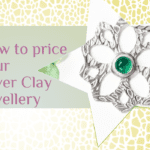Tumblers Vs. Rotary Tool – which is best for Silver Clay?
A question I get asked a lot by my new students especially is what’s the difference between a rotary tool – like a Dremel or Foredom and a tumbler. Which one should I buy?
And I get it, especially when you are starting out, you want to get as much bang for your buck as you can. But as with most things, it’s not a straightforward answer. You need to consider how you work, what are you producing, what you enjoy doing and your budget – always the budget 😉
You see silver clay and I mean only silver clay is such a lovely product, because almost all of your finishing work is done prior to firing. This means that provided you have done a good job tidying up, sanding and refining your piece at clay stage, the last polish should be an easy job. And to refine at clay stage is so much easier because you don’t need power tools!
Tumblers for Silver Clay
That’s where the tumbler comes in. After firing, you po straight in the tumbler. You can brush with a wire brush to start off the polishing process and cut down on tumbler time if you want to, but mostly I just bypass that step and go straight to tumbler. And for a good proportion of my work that’s perfectly adequate. The tumbler does a great job and my pieces end up nice and shiny after a few hours, whilst I get on with other things.
But that’s where the tumbler’s job and usefulness ends.
Rotary Tools for Silver Clay
The rotary tool is so much more than a polisher. You can do a number of jobs with this tool – the attachments you can buy for most rotary tools are mind boggling!
Let’s start off with polishing – it can do this easily – but you’ll need to go through the polishing grits one by one. I usually use 3M radial disks for polishing, and I will start with a wire stainless steel brush before moving onto the 3M disks and for most polishing I’ll use the final four colours (there are 6 in total).
It can be time consuming, since you have to follow this process for every piece and if you have lots, then could take some hours, Mind you, if you put a box set of something interesting on, then it might not bother you so much.
But the rotary tool can be used for so much more in addition to polishing. Depending on the attachments you invest in, it can saw, drill, set stones, repair and sand. These are useful when you start making more advanced pieces.
Things to consider if you decide to buy
If that sounds like a tool you need in your life, there are a few things to consider. It won’t surprise you to know that that there can be quite a cost difference in the market of rotary tools. When it comes to choosing the right rotary tool, you have to set a budget that works for you. The motor that you buy is important because you want to have something that is powerful enough to use it with confidence and that lasts!
The other thing is when you are using your rotary tool you have to think about the hand piece. Cheaper models have chunky hand pieces that can be cumbersome and awkward to hold for long periods of time. More expensive ones have a flexible shaft which is like a long cable that is attached to a hand piece where you can attach all your bits and pieces and use like a pen, much easier for longer term use.
My advice?
Well, when I started out, I invested in a tumbler and it did 99% of the work for me. After I did some silversmithing I invested in a rotary tool, which was about 5 years after I started silver clay. I didn’t feel the need for a rotary tool and didn’t miss it in the beginning.
I hope that this helps you! What did you decide to buy in the end?









Get a Proxxon with the flex shaft. Not only are they built better than the Dremel but they are also cheaper usually and have 2 years warranty. If you also need a drill press their design is built from metal parts and is accurate, unlike the wobbly Dremel press – ask me how I know 🙂
I bought mine from a German company. You need to get the UK adapter too (about £3.00) but cheaper than that famous next day delivery (not!) store 😉
https://www.reichelt.com/gb/en/precision-drill-grinder-fbs240e-proxxon-28472-p30177.html?PROVID=2788&wt_guka=92495611608_406948187429&PROVID=2788&gclid=EAIaIQobChMIrOv206CW6wIVwAiICR0avAzkEAYYAiABEgIpBfD_BwE&&r=1
Thanks for the blog, this is really good read. I was so caught up thinking I needed a rotary tool but knowing my tumbler should be enough is good to know 🙂
I started with normal silver work and so a tumbler was recommended as it not only polished work after pickling but it also work hardened pieces too, and I used it all the time.
I had an old dremel, but it was too bulky, I did get a flex shaft for it, but I think because it wasnt a pendant motor, it just didn’t work for me so I saved and saved until I could afford a Foredom pendant motor and I would not swap it for the work. I can put so many things in the quick change end of the standard handpiece, including a unit that I again saved up for and had to get from USA as they were not at that time available in England, that cuts my jumprings in one go instead of me sawing them by hand. Yesterday I finally after many years, got a hammer handpiece ready for a stone setting course I am going to be starting on. Too Excited lol.
I am like a kid in a candy store and a hoarder of tools, I just love looking at them and polishing the heads of my hammers so that they don’t mark my work etc. (I know I’m sad), but, I belonged to a group that was made up of jewellers, some professional and some noobs like me, and we had a polished hammer head competition!!
Anyway, getting back to the question, I would have to agree that a tumbler is the best thing to start off with, and then in time, move onto a pendant motor set up for doing other stuff as well as polishing.